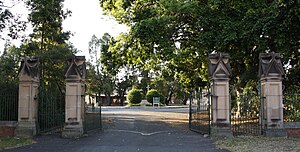Toowong Cemetery
 |
|
| Details | |
|---|---|
| Established | 1866 |
| Location | Toowong, Brisbane |
| Country | Australia |
| Coordinates | 27°28′27″S 152°58′58″E |
| Type | Monumental |
| Owned by | Brisbane City Council |
| Size | Forty-four hectares |
| No. of graves | Over 120,000 |
| Website | www.fotc.org.au |
The Brisbane General Cemetery also known as Toowong Cemetery is a heritage-listed cemetery located at Toowong, Brisbane, Queensland, Australia. It was established in 1866 and formally opened in 1875. It is Queensland's largest cemetery and is located on forty-four hectares of land at the corner of Frederick Street and Mount Coot-tha Road approximately four and a half kilometres west of Brisbane.
Brisbane's first cemetery was located close to the Brisbane city near the northern end of the William Jolly Bridge. It was bounded by Skew Street, Saul Street, Eagle Terrace and Upper Roma Street. As Brisbane expanded due to its opening to free settlement in 1842, growth was such that the cemetery was eventually surrounded by residential properties. The cemetery was moved to twenty five hectares of land between Milton Road, Hale Street, Sweetman Street and Dowse Street and was situated on the current site of Suncorp Stadium; it was known as Paddington cemetery or North Brisbane cemetery.
In 1861 200 acres (0.81 km2) of land was set aside for a new cemetery at Toowong. In 1870 a Cemetery Trust was established with trustees James Cowlishaw, John Hardgrave, William Pettigrew, Samuel Griffith, George Edmonstone, Alexander Raff, John Petrie (Chairman), Michael Quinlan and Nathaniel Lade the trustees to search for alternative sites as the Toowong site was considered by some as inappropriate. Colonel Samuel Blackall, Queensland's second Governor, had been a supporter of the Toowong site and in his ill health indicated his desire to be buried there — this was done when he was buried on the highest knoll on 3 January 1871. Even though Blackall had been buried, the search for an alternate site continued. The search was unsuccessful however and the Toowong site was eventually was accepted as the final location. Six more burials were performed before the official opening of the Cemetery in 1875.
In April 1975 the Cemetery was full with all plots having been sold. The Cemetery was closed to new burials except for family graves. The Brisbane City Council started a project to remove hundreds of worn, forgotten headstones in the three major city cemeteries. Old, neglected monuments (most of them really only had easily removed weeds) were removed from Toowong, Lutwyche and South Brisbane, Balmoral, God's Acre cemeteries and trees and shrubs planted. The long term aim of the scheme was to return the cemeteries to open space with a parkland atmosphere. Letters were sent to very old addresses and the graves were then demolished no matter how good the condition including soldiers graves. It is thought approximately 2500 memorials were demolished and buried in the canal at Toowong Cemetery.<FOTC>
...
Wikipedia
